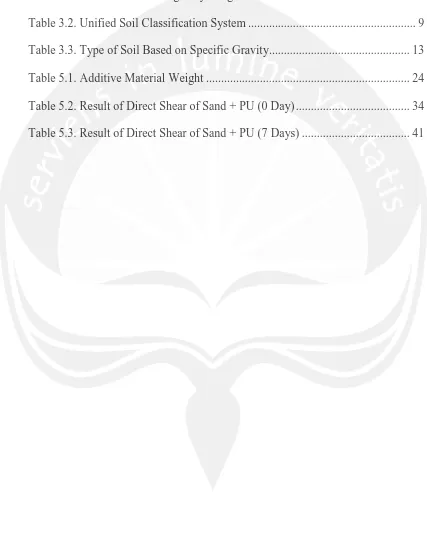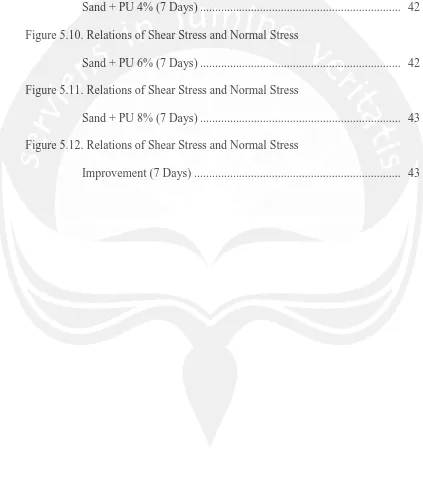SHEAR STRENGTH OF POLYURETHANE-RESIN
STABILIZED VOLCANIC SAND
Final Project Report
as a requirement to obtain Bachelor degree from Universitas Atma Jaya Yogyakarta
by:
YOHANES MEINATA PERMANA Student ID Number: 11 13 14048
INTERNATIONAL CIVIL ENGINEERING PROGRAM
DEPARTMENT OF CIVIL ENGINEERING
FACULTY OF ENGINEERING
UNIVERSITAS ATMA JAYA YOGYAKARTA
YOGYAKARTA
STATEMENT
I signed below, stating that the final project with the title :
“SHEAR STRENGTH OF POLYURETHANE
-RESIN
STAB
ILIZED VOLCANIC SAND”
It is the results of my ownwork and not a ressult of plagiarism of other people’s
work. Ideas, research data, and quotes directly or indirectly derived from the writings or ideas of others expressly provided in this Final Project. If it is proved later that the final project is the results of plagiarism. Which I get the certificate would be canceled and i will return to the Rector of the University of Atma Jaya Yogyakarta.
Yogyakarta, June 2016 Who made the remrks,
v
ACKNOWLEDGEMENT
First and foremost, I would like to thank to Jesus Christ for his blessing, therefore I can prepare and finish this final project well.
In this opportunity, I would like thank to:
1. Ir. John Tri Hatmoko, M.Sc., as my advisor, for his advice and counseling that has been given for the final project arrangement.
2. Dr. Eng. Luky Handoko, as the coordinator of Civil Engineering International Program.
3. J. Januar Sudjati, ST., MT., as the head of Civil Engineering Department of Atma Jaya Yogyakarta University.
4. All lecturers in civil engineering especially in international program who had educated me, therefore I can graduate from Atma Jaya Yogyakarta University. 5. Mr Wiko and Mr. Drajat, as the staff of Civil Engineering International
Program, for the help and friendship.
6. Mr. Oktoditya, as the staff of Soil Mechanics Laboratory, for the help and friendship.
7. My parent, Ir. B.A. Tjipto Sujitno, MT, APU – Agnes Sujarwati, BA and my sister, Yasinta Yerry Permana Sari, for their love and support.
8. My girlfriend, Theresia Putri Ratnawati, for his love and support.
vi
10.My comrades, Yohanes Aditya, Andreas Ryan, Ignatius Andi, and Judha Herdanta, for their love and motivation.
11.My best junior, Monika Brenna Hernindia Ratri, Digna Diva Koa, and Wikan Danastya, for their love, support, and help.
12.All my friends especially in Civil Engineering International Program, for their friendship and support.
13.All parties that can not be mentioned all, thank you for your support and help. I realize, this report has some mistakes. Therefore, I would like to apologize for that. Finally, I hope this report may be useful for the reader and me.
Yogyakarta, June 2016 The Author
vii
LIST OF APPENDICES ... xiii
MEANING OF SYMBOLS AND ABBREVIATIONS ... xiv
ABSTRACT ... xv
CHAPTER I. INTRODUCTION ... 1
1.1. Background ... 1
1.2. Problem statement ... 2
1.3. Objectives ... 2
1.4. Problem limitation ... 3
CHAPTER II. LITERATURE REVIEW ... 4
CHAPTER III. BASIC THEORIES ... 7
3.1. Soil Classification ... 7
3.1.1. AASHTO classification system ... 7
3.1.2. USCS classification system ... 8
viii
3.3. Sand ... 13
3.4. Polyurethane-Resin ... 14
3.5. Direct Shear Test ... 14
CHAPTER IV. RESEARCH METHODOLOGY ... 15
4.1. Framework of idea ... 15
4.2. Scope of Methodology... 17
4.2.1. Research material ... 17
4.2.2. Research equipement ... 18
4.3. Soil Classification Testing ... 19
4.3.1. Specific gravity ... 19
4.3.2. Water content ... 20
4.3.3. Sieve analysis ... 20
4.4. Soil Testing Without Additive Material ... 21
4.4.1. Direct shear test ... 21
4.5. Soil Testing With Additive Material ... 22
CHAPTER V. RESULTS AND ANALYSIS ... 24
5.1. Additive Material ... 24
5.2. Soil Classification Test ... 24
5.2.1. Grain size distribution ... 24
5.2.2. Specific gravity ... 25
5.2.3. Water content ... 25
5.3. Soil Testing Without Additive Material ... 26
ix
5.4. Soil Testing With Additive Material ... 29
5.4.1. Direct shear test (0 day) ... 29
5.4.2. Direct shear test (7 days) ... 37
CHAPTER VI. CONCLUSION AND SUGGESTION ... 45
6.1. Conclusion ... 45
6.2. Suggestion ... 46
REFERENCES ... 47
x
LIST OF TABLE
Table 3.1. Classification of Highway Subgrade Materials ... 8
Table 3.2. Unified Soil Classification System ... 9
Table 3.3. Type of Soil Based on Specific Gravity... 13
Table 5.1. Additive Material Weight ... 24
Table 5.2. Result of Direct Shear of Sand + PU (0 Day) ... 34
xi
LIST OF FIGURE
Figure 3.1. Flowchart Group Names for Gravelly and Sandy Soil ... 11
Figure 4.1. Framework of Idea ... 16
Figure 4.2. Soil Sample ... 17
Figure 4.3. LUX Car Refinish ... 18
Figure 4.4. Boiling Pycnometer to Release Air ... 19
Figure 4.5. Colling of Soil Samples on Desiccators ... 20
Figure 4.6. Sieve Analysis using Shaker ... 21
Figure 4.7. Direct Shear Test Apparatus... 22
Figure 5.1. Grain Size Distribution Curve ... 25
Figure 5.2. Relations of Shear Strength and Normal Stress Original Soil ... 29
Figure 5.3. Relations of Shear Stress and Normal Stress Sand + PU 2% (0 Day) ... 35
Figure 5.4. Relations of Shear Stress and Normal Stress Sand + PU 4% (0 Day) ... 35
Figure 5.5. Relations of Shear Stress and Normal Stress Sand + PU 6% (0 Day) ... 35
Figure 5.6. Relations of Shear Stress and Normal Stress Sand + PU 8% (0 Day) ... 36
xii
Figure 5.8. Relations of Shear Stress and Normal Stress
Sand + PU 2% (7 Days) ... 41 Figure 5.9. Relations of Shear Stress and Normal Stress
Sand + PU 4% (7 Days) ... 42 Figure 5.10. Relations of Shear Stress and Normal Stress
Sand + PU 6% (7 Days) ... 42 Figure 5.11. Relations of Shear Stress and Normal Stress
Sand + PU 8% (7 Days) ... 43 Figure 5.12. Relations of Shear Stress and Normal Stress
xiii
LIST OF APPENDICES
APPENDIX A Soil Classification ... 49
APPENDIX A-1 Sieve Analysis ... 50
APPENDIX A-2 Specific Gravity of Original Soil ... 51
APPENDIX B Original Soil Strength ... 49
APPENDIX B-1 Direct Shear Test of Original Soil ... 53
APPENDIX C Direct Shear Test ... 59
APPENDIX C-1 Direct Shear Test (0 Day) ... 60
xiv
MEANING OF SYMBOLS AND ABBREVIATIONS
w = Water Content (%)
ᵧ
wet = Wet Volume Weight (gr/cm3)ᵧ
dry = Dry Volume Weight (gr/cm3)G = Specific Gravity
c = Cohesion (kg/cm2)
xv
ABSTRACT
In construction project, knowing the type and characteristics of the soil is a very important thing. Not all soil have a good performance to support the structure above it. If the construction building is constructed above the weak soil, it is risky and susceptible to collapse because such soil has a differential settlements due to its poor shear strength and high compressibility. Therefore, an effort to change the soil characteristics to increase its engineering performance is highly required. Experiments to improve the strength of volcanic sand by the polyurethane-resin (PU) as additive material conducted in this research. The objectives of this research is to investigate the effects of adding polyurethane-resin for soil shear strength improvement. Specimens were prepared by adding different amount of polyurethane-resin (2%,4%,6%, and 8%) to volcanic sand. The shear strength of specimens determined with direct shear test and compared to each other with the different curing time condition (0 and 7 days) to get the effect of polyurethane-resin on volcanic sand. The results of this research indicated that the addition of polyurethane-resin improve the shear strength of sample. The optimum level of shear strength on sand + 8% PU at 7 days curing time with the average shear stress value is 0.131 kg/cm2 , it is increase 14.91% compared with the original soil shear strength. However, polyurethane-resin enhanced the strength of samples after 7 days of curing time, but the strength of 0 day curing time is less than the original soil without additive material.
Keywords: stabilization of volcanic sand, shear strength, polyurethane resin,

